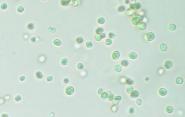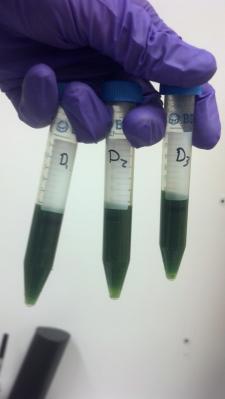Drawing From Microalgae As A Sustainable Resource

A barrel of microalgae has a lot to offer – the chemical compounds to make biodiesel, pharmaceuticals, and infant formula, to name just a few things. But getting all those things from the same barrel is no easy trick.
 Creating a bio-based economy, however, depends on finding cost-effective ways to produce biofuels and other products from a sustainable feedstock. To that end, researchers in the lab of Julie Zimmerman, professor of chemical and environmental engineering, have developed a method that not only extracts different compounds from microalgae – a microscopic form of algae - but separates those compounds by type for different uses. The results of their work are published in ACS Sustainable Chemistry & Engineering.
Creating a bio-based economy, however, depends on finding cost-effective ways to produce biofuels and other products from a sustainable feedstock. To that end, researchers in the lab of Julie Zimmerman, professor of chemical and environmental engineering, have developed a method that not only extracts different compounds from microalgae – a microscopic form of algae - but separates those compounds by type for different uses. The results of their work are published in ACS Sustainable Chemistry & Engineering.
In the recent study, the researchers specifically targeted triacylglycerides (TAGs). One of the valuable compounds that can be found in microalgae, the molecular structure of TAGs looks very similar. What sets different types of TAGs apart from each other are their carbon chain lengths and whether those carbons are attached by single or double bonds.
One approach for extracting TAGs from algae involves the use of carbon dioxide (CO2). While this method can extract high volumes of TAGs, simultaneously separating TAGs by type has been a challenge. With conventional methods, they all come out together, like “a big soup.”

The Yale researchers, however, developed a method to separate and purify the TAGs from microalgae. With a process called fractionation, they can essentially “tune” the extraction and target specific TAGs by adjusting the temperature and pressures of the CO2.
“Right now all the technologies and approaches target one product – biofuel, for example,” said Thomas Kwan, a Ph.D. student and lead author of the study. “It’s cost-prohibitive because the biofuel alone doesn’t justify the costs.”
Kwan said the extraction and fractionation of TAGs is just one of the sustainable technologies the lab is developing for a broader bio-based economy. Other valuable compounds can be extracted from microalgae as well, such as beta-carotene and phospholipids. Kwan said the ability to extract and separate multiple products is crucial to make algae a sustainable source.
“Our approach is to say ‘There’s all kinds of stuff in this barrel of algae, so we should develop sustainable technologies to pull out every last drop of value from that algae,'” he said. “Look at oil - every last drop of it is used. Gasoline, kerosene, polymers, plastics, diesel - we get all kinds of stuff out of a barrel of crude oil.”
If you can do that with algae, he said, you can develop biorefineries that transform biomass into biofuels and other products.

